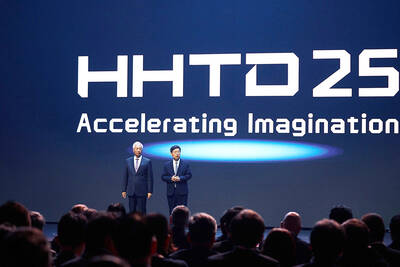Microsoft Corp announced yesterday that its latest operating systems (OS) — Windows 7 and Windows Server 2008 R2 — would be available on Oct. 22 after the company delivers the “release to manufacturing” (RTM) code in the second half of next month.
Steven Guggenheimer, Microsoft’s vice president for the original equipment manufacturing division, told a press conference at the Computex show in Taipei that the company’s manufacturing partners would launch hardware peripherals compatible with the new operating system by Oct. 22.
“The reason for the time gap between the RTM and commercialization is for our partners to migrate their technologies and produce compatible products for the public,” Guggenheimer said.
Microsoft had initially planned to launch Windows 7 early next year to replace the unpopular Vista operating system. But the company said recently it would adjust the scheduled launch to meet the shopping season demand later this year.
“It’s hard to believe it’s been a year since we first started to see small notebook PCs running Windows come to the market,” Guggenheimer said at a separate Windows 7 presentation yesterday.
“At the time, less than 10 percent of these devices were powered by Windows; now nearly 90 percent worldwide are Windows-based,” he said.
Guggenheimer said the move toward Windows OS from Linux on netbooks was consumer-driven and reflected the fact that netbooks had evolved into powerful PCs as opposed to the basic Web surfing tools they were designed for initially.
Microsoft, however, is facing another challenge as several PC manufacturers are adopting Google Inc’s Android OS in their products. On Tuesday, Acer Inc (宏碁) became the first PC vendor to unveil a prototype of an Android netbook. Other PC makers also have Android products in the pipeline.
Asked about the potential of Android-based or even Moblin-powered netbooks and the impact they might have on Windows 7 smartbooks or notebooks, Guggenheimer said it was too early to tell.
“It’s news versus reality. It takes time to see what really happens,” Guggenheimer said.
However, he said that Microsoft’s Windows Mobile 6.5 was an effective counterpart to Android-based smartphones, while Windows 7 is designed for fixed function devices that takes computing to a whole new level.
He said that the innovations of Windows 7 in the field of touch-screen technology would be specially suitable for all-in-one computers and tablet PCs.
Guggenheimer did not disclose the licensing fee for the new OS to Microsoft’s manufacturing partners, nor the retail price for Windows 7.

Shiina Ito has had fewer Chinese customers at her Tokyo jewelry shop since Beijing issued a travel warning in the wake of a diplomatic spat, but she said she was not concerned. A souring of Tokyo-Beijing relations this month, following remarks by Japanese Prime Minister Sanae Takaichi about Taiwan, has fueled concerns about the impact on the ritzy boutiques, noodle joints and hotels where holidaymakers spend their cash. However, businesses in Tokyo largely shrugged off any anxiety. “Since there are fewer Chinese customers, it’s become a bit easier for Japanese shoppers to visit, so our sales haven’t really dropped,” Ito

The number of Taiwanese working in the US rose to a record high of 137,000 last year, driven largely by Taiwan Semiconductor Manufacturing Co’s (TSMC, 台積電) rapid overseas expansion, according to government data released yesterday. A total of 666,000 Taiwanese nationals were employed abroad last year, an increase of 45,000 from 2023 and the highest level since the COVID-19 pandemic, data from the Directorate-General of Budget, Accounting and Statistics (DGBAS) showed. Overseas employment had steadily increased between 2009 and 2019, peaking at 739,000, before plunging to 319,000 in 2021 amid US-China trade tensions, global supply chain shifts, reshoring by Taiwanese companies and

Taiwan Semiconductor Manufacturing Co (TSMC) Chairman C.C. Wei (魏哲家) and the company’s former chairman, Mark Liu (劉德音), both received the Robert N. Noyce Award -- the semiconductor industry’s highest honor -- in San Jose, California, on Thursday (local time). Speaking at the award event, Liu, who retired last year, expressed gratitude to his wife, his dissertation advisor at the University of California, Berkeley, his supervisors at AT&T Bell Laboratories -- where he worked on optical fiber communication systems before joining TSMC, TSMC partners, and industry colleagues. Liu said that working alongside TSMC

TECHNOLOGY DAY: The Taiwanese firm is also setting up a joint venture with Alphabet Inc on robots and plans to establish a firm in Japan to produce Model A EVs Manufacturing giant Hon Hai Precision Industry Co (鴻海精密) yesterday announced a collaboration with ChatGPT developer OpenAI to build next-generation artificial intelligence (AI) infrastructure and strengthen its local supply chain in the US to accelerate the deployment of advanced AI systems. Building such an infrastructure in the US is crucial for strengthening local supply chains and supporting the US in maintaining its leading position in the AI domain, Hon Hai said in a statement. Through the collaboration, OpenAI would share its insights into emerging hardware needs in the AI industry with Hon Hai to support the company’s design and development work, as well